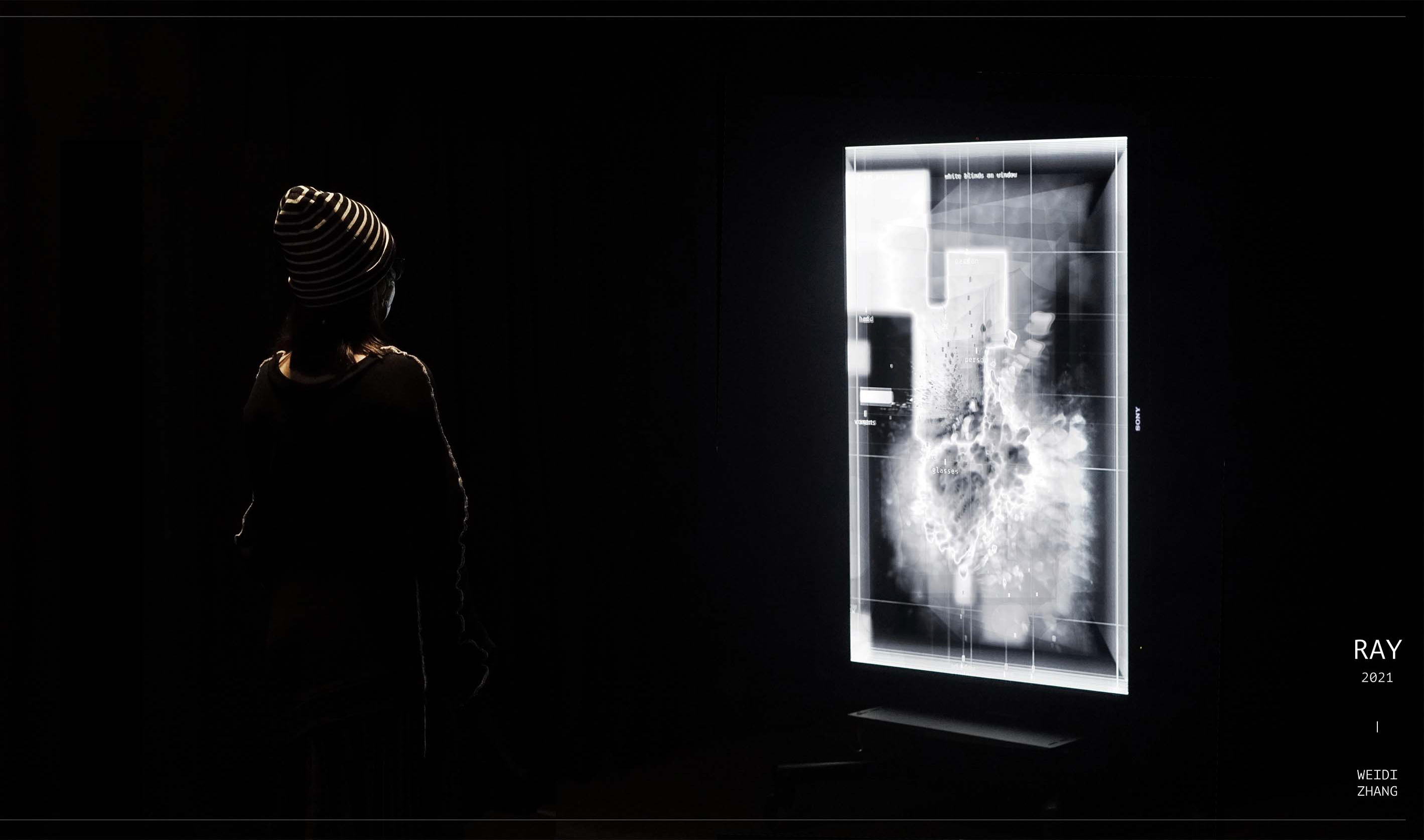“RAY” © copyright to Weidi Zhang
In 1921, visual artist Man Ray wrote that he wanted to “make my photography automatic — to use my camera as I would a typewriter.” This led to the creation of the term “Rayograph,” a unique approach to making photograms. This process involves placing objects directly onto a light-sensitive surface and exposing them to light. Ray’s approach inspired Weidi Zhang’s interactive AI artwork on “RAY,” which captures the visualization of a human-machine reality by transforming audiences’ portraits into an ever-evolving visual representation that combines graphics with abstraction and empathy. SIGGRAPH caught up with Zhang to discuss the inspiration behind her SIGGRAPH 2022 Best in Show Art Gallery installation.
SIGGRAPH: Tell us about the inspiration behind your SIGGRAPH 2022 Art Gallery project “RAY.”
Weidi Zhang (WZ): Many of my projects are inspired by art movements from the 20th century, including Cubism, Dada, Abstract Expressionism, Surrealism, and others. I started my art career as a fine art photographer when I was an undergraduate student. Early alternative photographic techniques, such as the Rayograph (photogram), always fascinated me. As a major contributor to the Dada and Surrealism movements, Man Ray coined the term “Rayograph” to describe his camera-less darkroom photographs. He revealed the dreamlike characteristics of daily objects by placing them in photosensitized paper and exposing them to light. His Rayographs are situated in between visual representation and abstraction, pointing to a new cameraless photographic method. A Rayograph is an image created by exposing light-sensitive photographic paper to light, where objects are placed on it to block areas of the paper. Variations of this technique are also implemented for scientific purposes such as X-rays, which are made by using external radiation to produce images of our body, and other internal structures for diagnostic purposes. “RAY” references alternative photography techniques by connecting human beings under surveillance cameras with objects for photograms, a metaphor for the power of the gaze.
SIGGRAPH: Why did you decide to create “RAY” through the lenses of artificial intelligent surveillance and the changing ontology of images? What challenges did you face when reinterpreting Rayograph?
WZ: Overall, the process of making this work was quite smooth. The most challenging part of this project is designing a system that can balance technological, aesthetic, and conceptual aspects. During this process, experimentation, trial, and error take a considerable amount of time. Several adjustments have been made to the trained model in order to produce better generative and interesting results, as well as designing all visual and sonic elements in order to enhance the cultural, conceptual, and aesthetic engagement of the experience.
SIGGRAPH: Man Ray wrote in 1921 that he wanted to “make my photography automatic — to use my camera as I would a typewriter.” Why is this type of visual representation important? How does your work contribute to the conversation that Ray started with Rayograph?
WZ: Today, we live under surveillance; our life moments and bodies have been captured, evaluated, and judged by the intelligent system behind the cameras. Image-making practices are beyond merely taking pictures that record light, such as operative images and generative images that emphasize instructional practices and autonomous systems. Countless images are no longer visual representations of the world made for humans to perceive but programmable data-based visualizations which result through automatic operations. The notion of the cameraless image-making process shifted from Rayograph to rule-based activities and synchronic data-to-data relationships. “RAY” aims to address the changing ontology of images under the gazes of machines by creating an intelligent system that incorporates automation with originality to generate a visualization of a human-machine reality. “RAY” creates a metaphor for the gazes of machines by asking: What is a contemporary Rayograph? What is the internal structure of a system that creates new images? Who are these systems designed to target? Is there any new aesthetic or cultural reproduction that can be generated by these systems? As a result, I designed a multimodal intelligent system that automatically transforms human portraits into new Rayographs with semantic meanings by training machine learning models to learn thousands of pairs of portraits and Rayographs.
SIGGRAPH: Congratulations on being awarded Best in Show at the SIGGRAPH 2022 Art Gallery for the second time! What does this representation mean to you?
WZ: Being awarded Best in Show for two consecutive years is such an honor, and I am deeply grateful to the SIGGRAPH committee for this award. It is also a huge encouragement for my art practices. My discussions with the SIGGRAPH community and other fantastic creators at the SIGGRAPH Art Gallery always spark my artistic practices and research. I am very happy to be a member of SIGGRAPH community.
SIGGRAPH: What do you hope SIGGRAPH 2022 participants took away from your Art Gallery installation?
WZ: I always like to present my art experiences openly and inclusively, which means I like presenting my works as a non-hierarchical cultural experience that brings critical and conceptual questions that might inspire future scenarios or thought experiments. The takeaway of my participants is based on their prior knowledge, and I believe that the beauty of experience design is to allow and respect distinct interpretations and understandings which will bring about the state that, as Allan Kaprow said, “The line between art and life should kept as fluid, and perhaps indistinct, as possible.”
SIGGRAPH: What advice would you give someone submitting to the SIGGRAPH Art Gallery for the first time?
WZ: From my personal perspective, the SIGGRAPH Art Gallery brings together diverse voices and visions through art and technology. It goes further than merely showing the creative and aesthetic implementation of innovative technologies, but most importantly, it engages in a critical, cultural, societal, environmental, political, and philosophical discussion on the challenging questions of our time. To envision the future by drawing inspiration from the past. It is also about crossing boundaries, recuperating disparate knowledge into a new entity by bridging machines and humans, automation and artistic originality, the virtual and real, as well as the past and the future.
SIGGRAPH 2023 submissions are now open! Submit to the Art Gallery by 31 January to have your work considered to be among this year’s installations. Submit now.

Weidi Zhang is an award-winning new media artist/designer and an assistant professor of immersive experience design at Arizona State University. Her interdisciplinary art and design research investigates A Speculative Assemblage at the intersection of immersive media design, experimental data visualization, and interactive AI art. Her works are featured in prestigious international awards, such as the Best in Show Awards in SIGGRAPH, Red Dot Design Award, Honorary Mention in Prix Ars Electronica, Juried Selection in Japan Media Arts Festival, Lumen Prize shortlists, and others. Her works have been exhibited at international venues such as ISEA, Times Art Museum, Society for Arts and Technology [SAT], SwissNex Gallery, CVPR, IEEE VISAP, Zeiss-Planetarium Jena, Planetarium 1, and others. She holds her Ph.D. in media arts and technology from the University of California, Santa Barbara, an MFA in art + technology at the California Institute of the Arts, and a BFA in photo/media from University of Washington, Seattle.



